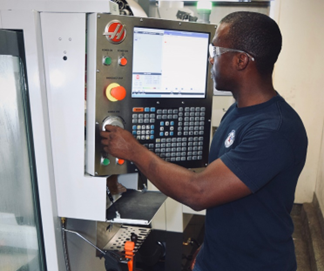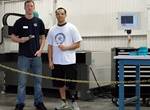Workshop for Warriors to Break Ground for Facility Expansion
Capital Campaign project raises $21 million for a new 25,000-square-foot facility that can accommodate higher student enrollment for quality training, educational programs and other opportunities.

Photo Credit: Workshop for Warriors
Hernán Luis y Prado, co-founder of Workshops for Warriors (WFW), has announced that they have broken ground on the Capital Campaign project, which began in 2017 — a project with a goal of raising $21 million to build a new facility that is able to accommodate ten times as many students as are currently enrolled. The event, which will be held on or before Nov. 30, 2022, is to highlight the demolition of four existing buildings in order to begin grading and shoring for a new 25,000-square-foot facility that is expected to be operational by April 2024.
WFW was founded by Hernán and his wife Rachel in 2008, both who self-financed the training provided in their own garage while Hernán was still in the service. They moved into their first small building in 2011 and moved into their current location in San Diego, California, in 2012. Recently, the couple was awarded “Best Small Business Person in California for 2022” by Isabella Casillas Guzman, head of the U.S. Small Business Administration.
The mission of WFW is to provide quality training, accredited STEM educational programs and opportunities to earn third-party nationally recognized credentials to enable veterans, transitioning service members and other students to be successfully trained and placed in their chosen advanced manufacturing career field. WFW is a fully audited, board-governed 501(c)(3) nonprofit and a Department of Defense (DOD) Skillbridge program offering accelerated four-month courses in spring, summer and fall semesters in CNC machining, welding and advanced welding. Their motto is “Rebuilding American Manufacturing, One Veteran at a Time.”
Hernán says students earn nationally recognized portable credentials from The American Welding Society (AWS), the National Institute for Metalworking Skills (NIMS), Mastercam University, SolidWorks, Immerse2Learn, the National Coalition of Certification Centers (NC3) and others.
Including the graduates of this class, WFW has graduated 1,070 students in the past 14 years who have earned 11,723 certifications. There are currently 12 instructors on staff, supported by an administrative staff of three in addition to CEO and founder, Hernán and his wife, Rachel, who is CFO and chief academic office.
More importantly, WFW enables veterans that have just taken off a uniform to take part in an organization that becomes their new family, helps them out financially and even provides a place to live while going through training if needed.
How did WFW fare during the pandemic lockdowns? “In response to COVID, the Workshops for Warriors team acted with military precision in 2020 and adapted our programs to a remote learning infrastructure in a single weekend,” Adam Jacobs, director of marketing of WFW, says. “Practical training was shifted to isolated individual instruction at staggered times, incorporating extensive PPE and cleaning protocols. We remained open, operational and safe during the pandemic.”
Related Content
-
MMT Chats: It’s Time to Play … The Moldmaker Card Game! Yes, a Game to Educate and Entertain
MoldMaking Technology Editorial Director Christina Fuges connects with Professor Steffen Ritter from Reutlingen University in Germany about the card game for moldmakers he developed to help promote and educate our next generation of moldmaking professionals in a fun way. This episode is brought to you by ISCAR with New Ideas for Machining Intelligently.
-
Making Mentoring Work | MMT Chat Part 2
Three of the TK Mold and Engineering team in Romeo, Michigan join me for Part 2 of this MMT Chat on mentorship by sharing how the AMBA’s Meet a Mentor Program works, lessons learned (and applied) and the way your shop can join this effort.
-
Unique Mold Design Apprenticeship Using Untapped Resources
To help fill his mold design skills gap, Jeff Mertz of Anova Innovations, is focused on high schools and underprivileged school districts, a school that has lower graduation and college entrance rates. The goal is a student-run enterprise.


.jpg;maxWidth=150;quality=70)









